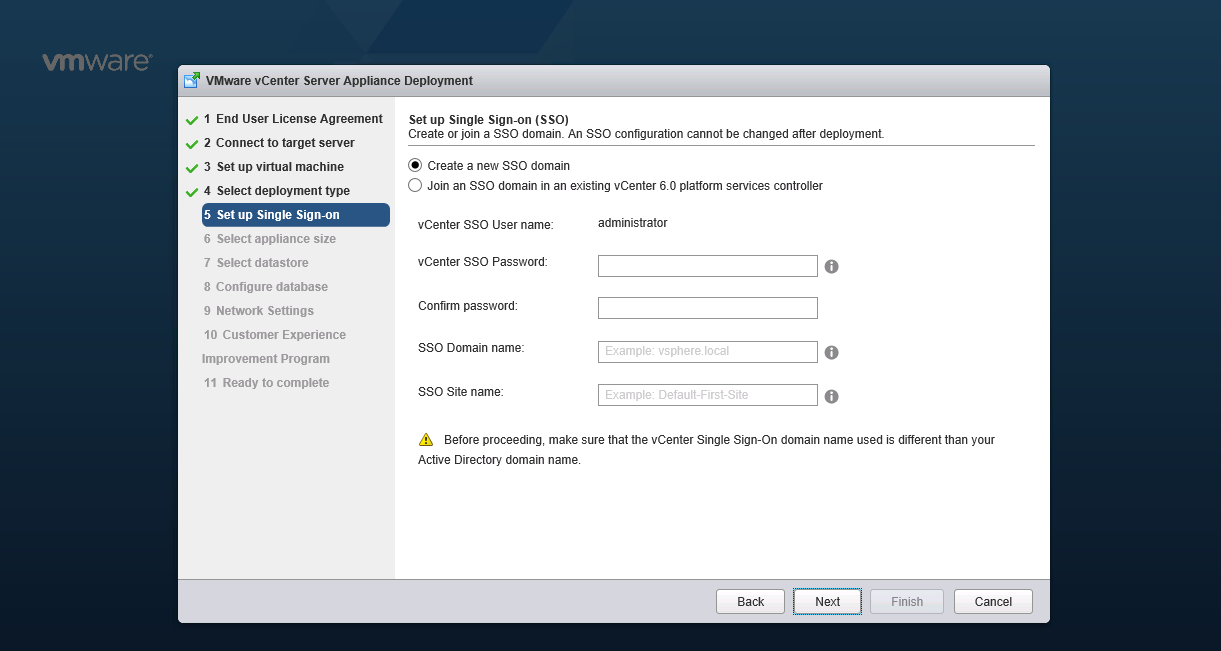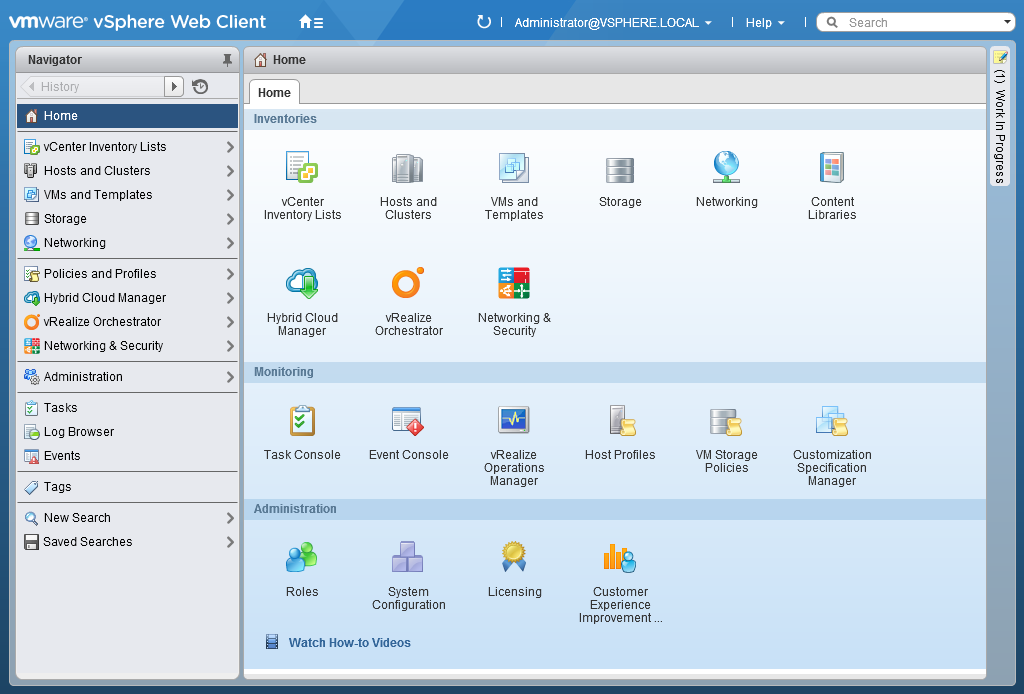How to Install Vcenter Server 6.0 Appliance
VMware vSphere 6.0 reached end of general support 12 March 2020, with vSphere 6.5 scheduled for 15 October 2022, both referenced in the VMware Lifecycle Matrix. See also How to Install vSphere 7.0. Upgrade to vSphere 7 can be achieved directly from vSphere 6.5.0 and above, whereas vSphere 6.0 requires an intermediate upgrade to 6.5 or 6.7 first. For more information see the VMware Upgrade Matrix. Finally, the Windows vCenter Server and external PSC deployment models are now depreciated and not available with vSphere 7.0.
VMware vCenter Server pools ESXi host resources to provide a rich feature set delivering high availability and fault tolerance to virtual machines. The vCenter Server is a centralised management application and can be deployed as a virtual appliance or Windows machine. This post gives a walk through on a clean installation of VCSA.
Software Considerations
- VCSA 6.0 must be deployed to an ESXi host running v5.x or above. All hosts you intend to connect to vCenter Server 6.0 should also be running ESXi v5.x or above.
- You must check compatibility of any third party products and plugins that might be used for backups, anti-virus, monitoring, etc. as these may need upgrading for use with vSphere 6.0.
- Should an external database be required then VCSA 6.0 only supports Oracle 11g and 12c.
- If you are unsure check the Product Interoperability Matrix.
Architectural Considerations
- The implementation of vSphere 6 introduces a Platform Services Controller (PSC) which contains infrastructure services such as Single Sign On, Certificate Authority, licensing, etc. The PSC is deployed internally with vCenter Server or as an external component. You can read more about the PSC in this kb.
- When implementing a new vSphere 6 environment you should plan your topology in accordance with the list of recommended topologies for VMware vSphere 6.
- For more information on deploying an external PSC see the Deploying an External PSC post.
- Most deployments will include the VCSA and PSC in one appliance, following the embedded deployment model, which I will use in this guide.

Other Considerations
- The VCSA with embedded PSC requires the following hardware resources (disk can be thin provisioned)
- Tiny (up to 10 hosts, 100 VMs) – 2 CPUs, 8 GB RAM, 120 GB disk.
- Small (up to 100 hosts, 1000 VMs) – 4 CPUs, 16 GB RAM, 150 GB disk.
- Medium (up to 400 hosts, 4000 VMs) – 8 CPUs, 24 GB RAM, 300 GB disk.
- Large (up to 1000 hosts, 10,000 VMs) – 16 CPUs, 32 GB RAM, 450 GB disk.
- Where the PSC is deployed as a separate appliance this requires 2 CPUs, 2 GB RAM, 30 GB disk.
- The ESXi host on which you deploy the VCSA should not be in lockdown or maintenance mode.
- All vSphere components should be configured to use an NTP server. The installation can fail or the vCenter Server Appliance vpxd service may not be able to start if the clocks are unsynchronized.
- FQDN resolution should be in place when deploying the VCSA in a production environment.
- Review the list of required ports for vCenter in this kb.
- Official resources – vSphere 6 Documentation Centre.
Installation
Download the VMware vCenter Server Appliance 6.0 ISO from VMware downloads.
Mount the ISO on your computer and open vcsa-setup.html. If you haven't already installed the VMware Client Integration plugin you will be asked to do so (this can be found in the vcsa folder). You will be prompted with the screen below, select Install.

Accept the license terms and click Ok.

Enter the FQDN or IP address of the host upon which you wish to deploy the new VCSA. Enter the credentials of an administrative or root user and click Next. The installer will validate access to the host, if prompted with an untrusted SSL certificate message click Yes to continue.

Enter the name of the VCSA and a root password, click Next.

Select the deployment model, in this example we will be using an embedded deployment combining the vCenter Server and Platform Services Controller in one appliance, click Next.

Select to create a new SSO domain, unless you have an existing PSC in your environment. Enter a password for the SSO administrator. The SSO domain name is unique to your deployment, however the default is vsphere.local. The SSO domain name should not be the same as your Active Directory Domain. Enter a site name, and click Next.

Select the appliance size in line with the number of hosts and virtual machines listed in the other considerations part of this guide, click Next.
Select the datastore where the VCSA will be deployed, you can also select thin provisioning here, click Next.
Choose an embedded PostgreSQL database or external Oracle database and click Next.

Configure the network and NTP settings for the appliance and click Next.

Select or deselect the customer experience improvement program box and click Next.

Review the details on the summary page and click Finish.

The VCSA will now be deployed and configured.

Post-Installation
Connect to the vCenter post install using the IP or FQDN of the VCSA, and select Log in to the vSphere Web Client. Using the SSO administrator login, verify the installed version is correct when selecting the vCenter under Hosts and Clusters, you can also go to Help > About.

You must apply a new vCenter license key within 60 days:
Web client: Click Hosts and Clusters and select the upgraded vCenter. Click Actions and Assign License. Select a license or use the green plus button to add a new license and click Ok.
Windows client: On the Home screen under Administration click vCenter Server Settings. Under licensing select a license or enter a new key under Assign a new license key to this vCenter Server and click Ok.
You can obtain a 60 day trial license for vCenter Server here. If you have purchased vCenter Server then log into your licensing portal here. If the license key does not appear then check with your VMware account manager.

If you are have an Active Directory domain then vCenter can use this as a source for permissions and sign on credentials. First join the vCenter to the domain; from the home page click System Configuration, Nodes, and select the vCenter server. In the Active Directory section of the Manage tab click Join, input your AD details and click Ok. Reboot the appliance either right clicking the vCenter server under Nodes and selecting Reboot.
When the vCenter server comes back online we can add AD as an identity source; from the home page click Administration, under Single Sign-On select Configuration. Ensure the Identity Sources tab is open and click the green plus symbol to add a source. Fill in the Active Directory details for your domain and click Ok.

You can now add permissions to vCenter objects such as datacentres, clusters, folders, individual virtual machines, etc. for Active Directory users and groups by selecting the object and clicking Permissions under the Manage tab. To learn more about how vSphere permissions work review the vSphere permissions documentation section.
How to Install Vcenter Server 6.0 Appliance
Source: https://esxsi.com/2016/10/26/vcsa/